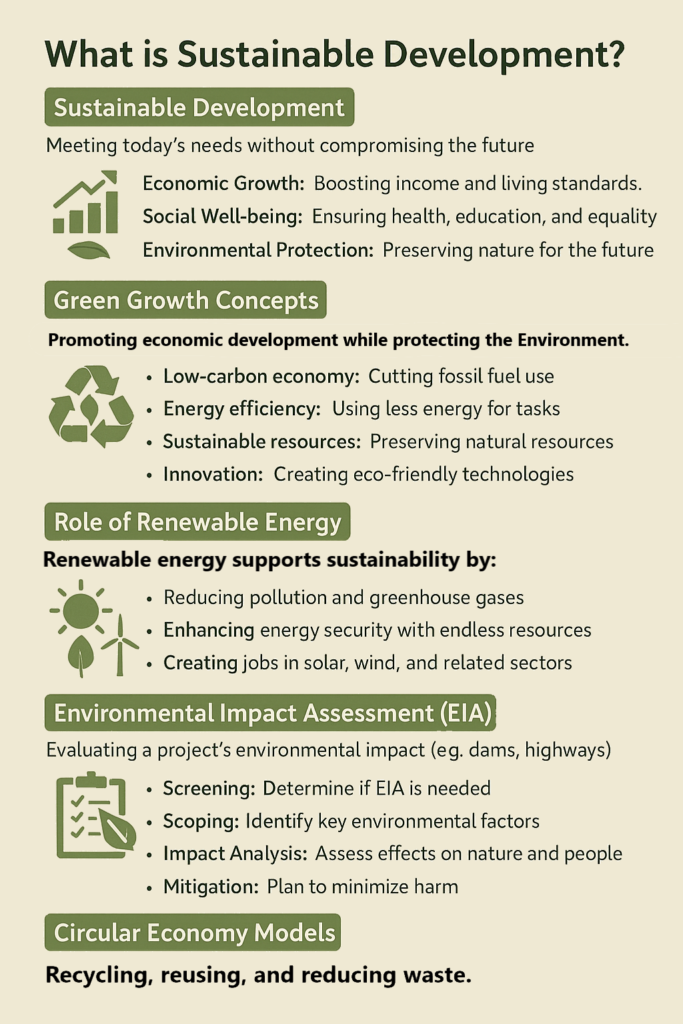What is Sustainable Development?
Sustainable Development means meeting the needs of the present without compromising the ability of future generations to meet their own needs. It focuses on balancing economic growth, social well-being, and environmental protection.
Think of it like this:
- Economic Growth: Making money and improving living standards.
- Social Well-being: Ensuring people have good health, education, and equality.
- Environmental Protection: Taking care of nature so it remains healthy for future generations.

Concepts of Green Growth
Green Growth is about growing the economy while protecting the environment. It aims to create jobs, boost the economy, and reduce pollution.
Key Ideas of Green Growth:
- Low-Carbon Economy: Reducing the use of fossil fuels like coal and oil.
- Energy Efficiency: Using less energy to do the same things.
- Sustainable Resources: Using natural resources wisely so they don’t run out.
- Innovation: Developing new technologies that are eco-friendly.
Role of Renewable Energy in Sustainability
Renewable Energy comes from natural sources that never run out, like the sun, wind, water, and biomass. It plays a big role in sustainability because it:
- Reduces Pollution: Less harmful emissions compared to coal or oil.
- Fights Climate Change: Helps decrease greenhouse gases.
- Provides Energy Security: We won’t run out of sunlight, wind, or water.
- Creates Jobs: In industries like solar panel production and wind farms.
Environmental Impact Assessment (EIA)
An Environmental Impact Assessment (EIA) is a process used to check how a project (like building a dam, factory, or highway) will affect the environment.
Steps in EIA:
- Screening: Decide if the project needs an EIA.
- Scoping: Identify what environmental factors to study (air, water, wildlife).
- Impact Analysis: Study the potential effects on nature and people.
- Mitigation Measures: Plan how to reduce any negative impacts.
- Reporting: Prepare a report (EIA report) for authorities to review.
- Decision Making: Authorities decide whether to approve or reject the project.
Circular Economy Models
A Circular Economy is a way of using resources that focuses on recycling, reusing, and reducing waste. Instead of the traditional “take, make, dispose” model, it’s more like “make, use, return.”
Key Principles of Circular Economy:
- Design for Longevity: Make products that last longer and are easy to repair.
- Reuse: Use items multiple times instead of throwing them away.
- Recycle: Turn waste materials into new products.
- Reduce Waste: Create less waste in the first place.
Examples:
- Recycling plastic bottles to make new ones.
- Repairing electronics instead of buying new ones.
- Using waste materials in construction, like recycled glass in roads.
Summary:
- Sustainable Development is about balancing growth, well-being, and nature.
- Green Growth means growing the economy without harming the environment.
- Renewable Energy helps reduce pollution and fight climate change.
- EIA helps identify and reduce environmental harm from new projects.
- Circular Economy focuses on reusing and recycling to minimize waste.
Tags: biomass, Circular Economy, climate change, construction waste reuse., Decision Making, Design for Longevity, eco-friendly technologies, economic growth, economy, EIA, EIA report, electronic repair, Energy Efficiency, energy security, Environmental Impact Assessment, Environmental Protection, fossil fuels, future generations, Green Growth, greenhouse gases, impact analysis, innovation, jobs, Low-Carbon Economy, make-use-return, mitigation measures, natural sources, plastic bottle recycling, pollution, recycle, Recycling, reduce waste, reduces pollution, reducing waste, Renewable Energy, reuse, reusing, scoping, screening, social well-being, solar panels, sun, Sustainable Development, Sustainable Resources, take-make-dispose, water, wind, wind farms


